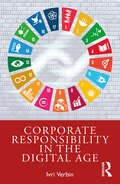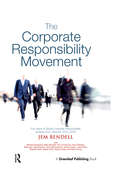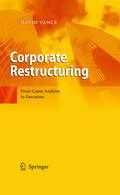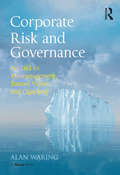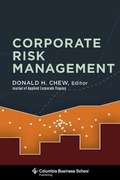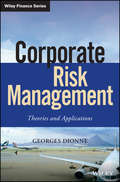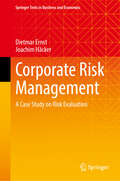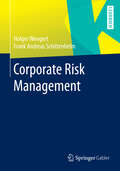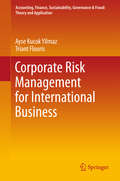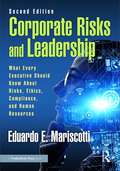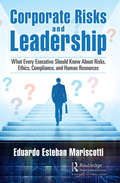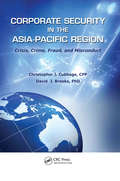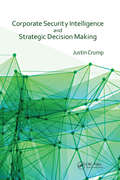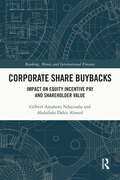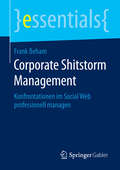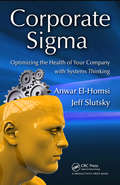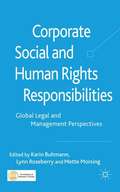- Table View
- List View
Corporate Responsibility for Wealth Creation and Human Rights
by Georges EnderleGeorges Enderle proposes a radically new understanding of corporate responsibility in the global and pluralistic context. This book introduces a framework that integrates the ideas of wealth creation and human rights, which is illustrated by multiple corporate examples, and provides a sharp critique of the maximizing shareholder value ideology. By defining the purpose of business enterprises as creating wealth in a comprehensive sense, encompassing natural, economic, human and social capital while respecting human rights, Enderle draws attention to the fundamental importance of public wealth, without which private wealth cannot be created. This framework further identifies the limitations of the market institution and self-regarding motivations by demonstrating that the creation of public wealth requires collective actors and other-regarding motivations. In line with the UN's Guiding Principles on Business and Human Rights, this book provides clear ethical guidance for businesses around the world and a strong voice against human right violations, especially in repressive and authoritarian regimes and populist and discriminatory environments.
Corporate Responsibility in the Digital Age: A Practitioner’s Roadmap for Corporate Responsibility in the Digital Age
by Ivri VerbinThis book is a roadmap to help organizations adopt corporate responsibility and sustainability practices and be fit for purpose in a digital era. It explains why corporate responsibility is the only option in the twenty-first-century post-COVID-19 world, and guides readers through the process of transforming their organizations with continued reference to the importance of technology. This is not a technical manual, and it is not an academic textbook: it is designed to be a quick, easily digested read. The first part looks at the current landscape – both of business and of the world in which it operates. The second part explains why corporate responsibility is the only realistic option for business in the twenty-first-century, post-COVID, and who needs to take responsibility for it. The third part is a step-by-step guide to putting principles into practice, covering: values, stakeholder engagement, employees, supply chain, environment, community, customers and marketing, and reporting and transparency. Each chapter is linked to relevant UN Sustainable Development Goals and supported by dozens of real-world examples. By the end of the book, business leaders will have understood the scope of the challenge involved in leading a truly socially and environmentally responsible organization, and, crucially, will have understood why such a course of action is not only desirable but essential. And they will also have been inspired by a sense of purpose. The book offers direct access to the processes, insights, and techniques for installing corporate responsibility throughout organizations large and small, based on the author’s many years’ experience working in government and with successful large corporations. It is up-to-date and relevant, addressing the implications of COVID-19 and the modern technological “Fourth Industrial Revolution.”
The Corporate Responsibility Movement: Five Years of Global Corporate Responsibility Analysis from Lifeworth, 2001-2005
by Jem BendellCorporate social responsibility is now an established agenda for large companies, with a new profession emerging that engages in the social and environmental contribution of business. How has this agenda emerged over time? What were the key events and actors? How has this new "movement" of committed individuals been taking shape around the globe? Insights into these questions come from a review of the first half of first decade of the 21st century. The Corporate Responsibility Movement compiles Lifeworth's highly praised Annual Reviews of Corporate Responsibility from 2001 to 2005.It is introduced with a new overview by the lead author of those reviews, Dr Jem Bendell, in a piece that examines the trajectory of a new social movement in and around business. At a time of searching questions about the future of finance, Dr Bendell argues that a new concept of "capital democracy" is emerging from within the community of people working towards corporate responsibility, which could be mainstreamed as a socially and environmentally enhanced system of economy. He calls on professionals, researchers and policy-makers to embrace an ambitious agenda for corporate responsibility and develop greater insight into acting together as a movement for change.This book is an essential resource for business libraries, recording, analysing and contextualising some of the key events, issues and trends during this historic period in the development of the corporation.
Corporate Responsibility, Sustainability and Markets: How Ethical Organisations and Consumers Shape Markets (Palgrave Studies in Governance, Leadership and Responsibility)
by Cláudia Simões Alin Stancu Georgiana GrigoreThis book explores the interaction between sustainability, corporate responsibility, consumers, and the market. It aims to discover if consumers are seeking out small, ethical, socially responsible firms to buy from rather than large corporations; if markets and organisations are supported by a new sensitivity to social responsibility and sustainability ideas; if the integration of corporate responsibility strategies and practices change how market sectors are assembled. Bringing together international case studies – including research on the Italian wine industry, German butchers, Spanish football, Polish marketing and the Portuguese financial sector – this book is valuable reading for scholars working on corporate social responsibility, sustainability, and good governance.Chapter 12 is available open access under a Creative Commons Attribution 4.0 International License via link.springer.com.
Corporate Restructuring: From Cause Analysis to Execution
by David VanceCorporate Restructuring is a practical approach to rescuing troubled companies and driving underperforming companies to top performance. It combines proven restructuring strategies with rigorous theoretical analysis. This book explains how to set and achieve asset, staffing, sales and profit goals. Topics include diagnostic tools to identify the root cause of problems, the human dynamics that cause a company to thrive or wither, customer service and relationship marketing, customer intelligence systems, new product development, process mapping, continuous process improvement and re-engineering as well as integrating IT into corporate strategy. It is also discussed how to find the resources needed to keep a company alive during restructuring and how to use bankruptcy offensively and defensively. Corporate Restructuring emphasizes execution. All the restructuring theories in the world weigh less than a simple plan, well executed.
Corporate Risk and Governance: An End to Mismanagement, Tunnel Vision and Quackery
by Alan WaringCorporate Risk and Governance addresses corporate risk management and governance requirements affecting large organizations in all industry sectors and countries. The book strongly advocates implementation of Corporate Governance Codes, ISO 31000 Risk Management, ISO 22301 Business Continuity Management and PAS 200 Crisis Management but warns against treating any standard or model slavishly, as if it can offer easy salvation or a simple route to a risk nirvana. Alan Waring challenges many hallowed beliefs, attitudes and practices that continue to hamper the delivery of effective Enterprise Risk Management (ERM) and thereby good governance. Those boardroom and corporate cultures that are complacent about risk exposures and risk management or, worse, encourage ’chancers’ and a ’what can we get away with’ attitude, are examined in depth along with what is required to embed a culture of responsible risk-taking. Some 75 cases from around the world provide graphic examples and lessons to be learned. Although the text includes some summary practical guidance, this book is designed primarily as a thinking aid rather than a risk management cookbook. It is something to encourage better informed risk-decision making; a more informed view of enterprise risk exposures, control and mitigation issues and an awareness of boardroom and corporate culture issues and their impact on effective ERM.
Corporate Risk Management
by Chew Donald H.More than 30 leading scholars and finance practitioners discuss the theory and practice of using enterprise-risk management (ERM) to increase corporate values. ERM is the corporate-wide effort to manage the right-hand side of the balance sheet& mdash;a firm's total liability structure-in ways that enable management to make the most of the firm's assets. While typically working to stabilize cash flows, the primary aim of a well-designed risk management program is not to smooth corporate earnings, but to limit the possibility that surprise outcomes can threaten a company's ability to fund its major investments and carry out its strategic plan. Contributors summarize the development and use of risk management products and their practical applications. Case studies involve Merck, British Petroleum, the American airline industry, and United Grain Growers, and the conclusion addresses a variety of topics that include the pricing and use of certain derivative securities, hybrid debt, and catastrophe bonds. Contributors: Tom Aabo (Aarhus School of Business); Albéric Braas and Charles N. Bralver (Oliver, Wyman & Company); Keith C. Brown (University of Texas at Austin); David A. Carter (Oklahoma State University); Christopher L. Culp (University of Chicago); Neil A. Doherty (University of Pennsylvania); John R. S. Fraser (Hyrdo One, Inc.); Kenneth R. French (University of Chicago); Gerald D. Gay (Georgia State University); Jeremy Gold (Jeremy Gold Pensions); Scott E. Harrington (University of South Carolina); J. B. Heaton (Bartlit Beck Herman Palenchar & Scott LLP); Joel Houston (University of Florida); Nick Hudson (Stern Stewart & Co.); Christopher James (University of Florida); A. John Kearney and Judy C. Lewent (Merck & Co., Inc.); Robert C. Merton and Lisa K. Meulbroek (Harvard Business School); Merton H. Miller (University of Chicago); Jouahn Nam (Pace University); Andrea M. P. Neves (CP Risk Management LLC); Brian W. Nocco (Nationwide Insurance); André F. Perold (Harvard Business School); S. Waite Rawls III (Continental Bank); Kenneth J. Risko (Willis Risk Solutions); Angelika Schöchlin (University of St. Gallen); Betty J. Simkins (Oklahoma State University); Donald J. Smith (Boston University); Clifford W. Smith Jr. (University of Rochester); Charles W. Smithson (Continental Bank); René M. Stulz (Ohio State University); D. S All the articles that comprise this book were first published in the Journal of Applied Corporate Finance. Morgan Stanley's ownership of the journal is a reflection of its commitment to identifying outstanding academic research and promoting its application in the practicing corporate and investment communities.
Corporate Risk Management: Strategies Management (Columbia Business School Publishing Ser.)
by Chew Donald H. Ed.More than thirty leading scholars and finance practitioners discuss the theory and practice of using enterprise-risk management (ERM) to increase corporate values. ERM is the corporate-wide effort to manage the right-hand side of the balance sheet-a firm's total liability structure-in ways that enable management to make the most of the firm's assets. While typically working to stabilize cash flows, the primary aim of a well-designed risk management program is not to smooth corporate earnings, but to limit the possibility that surprise outcomes can threaten a company's ability to fund its major investments and carry out its strategic plan. Contributors summarize the development and use of risk management products and their practical applications. Case studies involve Merck, British Petroleum, the American airline industry, and United Grain Growers, and the conclusion addresses a variety of topics that include the pricing and use of certain derivative securities, hybrid debt, and catastrophe bonds.Contributors: Tom Aabo (Aarhus School of Business); Albéric Braas and Charles N. Bralver (Oliver, Wyman & Company); Keith C. Brown (University of Texas at Austin); David A. Carter (Oklahoma State University); Christopher L. Culp (University of Chicago); Neil A. Doherty (University of Pennsylvania); John R. S. Fraser (Hyrdo One, Inc.); Kenneth R. French (University of Chicago); Gerald D. Gay (Georgia State University); Jeremy Gold (Jeremy Gold Pensions); Scott E. Harrington (University of South Carolina); J. B. Heaton (Bartlit Beck Herman Palenchar & Scott LLP); Joel Houston (University of Florida); Nick Hudson (Stern Stewart & Co.); Christopher James (University of Florida); A. John Kearney and Judy C. Lewent (Merck & Co., Inc.); Robert C. Merton and Lisa K. Meulbroek (Harvard Business School); Merton H. Miller (University of Chicago); Jouahn Nam (Pace University); Andrea M. P. Neves (CP Risk Management LLC); Brian W. Nocco (Nationwide Insurance); André F. Perold (Harvard Business School); S. Waite Rawls III (Continental Bank); Kenneth J. Risko (Willis Risk Solutions); Angelika Schöchlin (University of St. Gallen); Betty J. Simkins (Oklahoma State University); Donald J. Smith (Boston University); Clifford W. Smith Jr. (University of Rochester); Charles W. Smithson (Continental Bank); René M. Stulz (Ohio State University); D. SAll the articles that comprise this book were first published in the Journal of Applied Corporate Finance. Morgan Stanley's ownership of the journal is a reflection of its commitment to identifying outstanding academic research and promoting its application in the practicing corporate and investment communities.
Corporate Risk Management: Theories and Applications (Wiley Finance)
by Georges DionneAn updated review of the theories and applications of corporate risk management After the financial crisis of 2008, issues concerning corporate risk management arose that demand new levels of oversight. Corporate Risk Management is an important guide to the topic that puts the focus on the corporate finance dimension of risk management. The author—a noted expert on the topic—presents several theoretical models appropriate for various industries and empirically verifies theoretical propositions. The book also proposes statistical modeling that can evaluate the importance of different risks and their variations according to economic cycles. The book provides an analysis of default, liquidity, and operational risks as well as the failures of LTCM, ENRON, and financial institutions that occurred during the financial crisis. The author also explores Conditional Value at Risk (CVaR), which is central to the debate on the measurement of market risk under Basel III. This important book: Includes a comprehensive review of the aspects of corporate risk management Presents statistical modeling that addresses recent risk management issues Contains an analysis of risk management failures that lead to the 2008 financial crisis Offers a must-have resource from author Georges Dionne the former editor of The Journal of Risk and Insurance Corporate Risk Management provides a modern empirical analysis of corporate risk management across industries. It is designed for use by risk management professionals, academics, and graduate students.
Corporate Risk Management: A Case Study on Risk Evaluation (Springer Texts in Business and Economics)
by Dietmar Ernst Joachim HäckerIn times of crisis, risk management is more important than ever. In addition, companies are obliged to identify, quantify and aggregate risks as part of a risk management system. Legal and auditing standards have set the framework for doing so. This book uses a case study to show ‘step by step’ how risks can be analyzed and quantified with the help of Microsoft Excel. The book begins with the graphical representation of risks and the calculation of risk parameters such as the value at risk. It subsequently aggregates different risks into an overall risk using Monte Carlo simulation. Hedging risks is also explained, and how non-hedgeable risks can be integrated into a business plan. The assessment of extreme risks is also addressed, as is the modeling of volatilities. The book is aimed at students of business administration with a focus on finance.
Corporate Risk Management
by Tony Merna Faisal F. Al-ThaniThe book analyzes, compares, and contrasts tools and techniques used in risk management at corporate, strategic business and project level and develops a risk management mechanism for the sequencing of risk assessment through corporate, strategic and project stages of an investment in order to meet the requirements of the 1999 Turnbull report. By classifying and categorizing risk within these levels it is possible to drill down and roll-up to any level of the organizational structure and to establish the risks that each project is most sensitive to, so that appropriate risk response strategies may be implemented to benefit all stakeholders."The new edition of this book provides a clear insight into the intricacies of corporate risk management and the addition of the case study exemplars aids understanding of the management of multiple projects in the real world."--Professor Nigel Smith, Head of the School of Civil Engineering, University of Leeds
Corporate Risk Management
by Holger Wengert Frank Andreas SchittenhelmDas Buch soll Firmen und Studenten in das Risikomanagement von Unternehmen einführen und gibt einen komprimierten Einblick in das Themengebiet. Die Autoren beschäftigen sich zunächst mit den Grundlagen des Risikomanagements, u. a. werden die Bedeutung des Risikomanagements für Nachhaltigkeit und Innovationsmanagement herausgearbeitet und rechtliche Rahmenbedingungen aufgezeigt. Darüber hinaus werden organisatorische Aspekte sowie die Bedeutung von Anwendungs-Software erläutert. Anschließend wird ausführlich auf das strategische Risikomanagement eingegangen. Im dritten Teil wird der operative Risikomanagement-Prozess behandelt. In Beispielen und anschaulichen Grafiken wird das Risikomanagement greifbar gemacht. Im abschließenden Teil geben die Autoren einen Überblick über die wesentlichen Aspekte der Solvabilitätsanforderungen gemäß Basel III und Solvency II.
Corporate Risk Management for International Business (Accounting, Finance, Sustainability, Governance & Fraud: Theory and Application)
by Ayse Kucuk Yilmaz Triant FlourisThis book presents research on how businesses can be empowered to manage their company's risk exposure in international settings. It elaborates on approaches that advocate the minimizing of threats and sizing opportunities as the best strategy through which corporate objectives are maximized. With a focus on international business management, the book starts off with a review of literature and companies that are international in nature, before presenting several main chapters that highlight the different vital sides of both international business and risk management. Corporate Risk Management for International Business serves as a key source for managers and academic researchers in risk management and strategy to understand all related issues of managing risks and setting strategies in global way. The book also serves as a decision making guide for managers that are active in volatile and dynamic environments of international business.
Corporate Risks and Leadership: What Every Executive Should Know About Risks, Ethics, Compliance, and Human Resources
by Eduardo E. MariscottiThe context of business has been changing for companies in recent years, and following numerous corporate and accounting scandals, many countries have increased the number of national and international regulations designed to ensure transparency and compliance with the law. Because of the existence of these new regulations, the level of control, the severity of sanctions by governments, and the amount of fines for noncompliance have increased dramatically.In parallel, with the technological revolution in communications, business management has become more transparent, and any negative event is uploaded to social networks and shared with an indeterminate number of people. This change in the regulatory, sanctioning, and technological context has forced large companies to rethink risks, investments, and budgets to deal with this more complex environment.To transition to this change, some companies have included ethics and compliance programs in their corporate agenda, along with marketing and sales plans, strategies, growth targets, investment plans, and/or talent acquisition. While each industry has its particular risks, in this book, the author describes the essential elements that any effective ethics and compliance program should contain.This book is a source of information that connects yesterday with today. The author shares observations and lessons of the past to suggest corporate leaders implement effective ethics and compliance programs to protect their organizations and themselves. This book covers theories of ethics but with an eye focused on practical application. Risks, ethics, and compliance are analyzed with an overall vision, connected to the reality of business life, without getting bogged down in abstract thinking or technical and regulatory details.Ethics and compliance are disciplines that have increasingly achieved greater recognition in organizations. Thus, due to the importance of risk management in the business world and the necessary involvement of the CEO and the board of directors, it seems appropriate that executives get access to this book about risks, ethics, compliance, and human resources directed not only to compliance experts but also to any organizational leader.This second edition offers various examples to cultivate ethical thinking and behavior, identify common risks, and comprehend their adverse effects on organizations.
Corporate Risks and Leadership: What Every Executive Should Know About Risks, Ethics, Compliance, and Human Resources
by Eduardo Esteban MariscottiThe context of business has been changing for companies in recent years, and following numerous corporate and accounting scandals, many countries have increased the number of national and international regulations designed to ensure transparency and compliance with the law. Because of the existence of these new regulations, the level of control, the severity of sanctions by governments, and the amount of the fines for noncompliance have increased dramatically. In parallel, with the technological revolution in communications, business management has become more transparent, and any negative event is uploaded to social networks and shared with an indeterminate number of people. This change in the regulatory, sanctioning and technological context has forced large companies to rethink risks, investments and budgets to deal in this more complex environment. To transition to this change, some companies have included ethics and compliance programs in their corporate agenda, along with marketing and sales plans, strategies, growth targets, investment plans and/or talent acquisition. While each industry has its particular risks, in this book, the author describes the essential elements that any effective ethics and compliance program should contain. This book is a source of information that connects yesterday with today. The author shares observations and lessons of the past to suggest corporate leaders implement effective ethics and compliance programs to protect their organizations and themselves. The book covers theories of ethics but with an eye focused on practical application. Risks, ethics, and compliance are analyzed with an overall vision, connected to the reality of business life, without getting bogged down in abstract thinking or in technical and regulatory details. Ethics and compliance are disciplines that have increasingly achieved greater recognition in organizations. Thus, due to the importance of risk management in the business world and the necessary involvement of the CEO and the board of directors, it seems appropriate that executives get access to a book about risks, ethics, compliance and human resources directed not only to compliance experts but also to any organizational leader. This book is a wake-up call that allows business leaders to understand the benefits of implementing an effective ethics and compliance program that will help members of organizations to make the right decisions and act within the law. If they do, they can better prevent and react to the difficult obstacle course of risks, dangers and threats that organizations face and that may jeopardize the sustainability, resilience, and survival of companies.
Corporate Sector Restructuring
by Mark R. StoneExamines the steps involved in restructuring the corporate sector. Large-scale corporate restructuring made necessary by a financial crisis is one of the most daunting challenges faced by economic policymakers. The government is forced to take a leading role, even if indirectly, because of the need to prioritize policy goals, address market failures, reform the legal and tax systems, and deal with the resistance of powerful interest groups.
Corporate Security in the 21st Century
by Kevin Walby Randy K. LippertThis interdisciplinary collection places corporate security in a theoretical and international context. Arguing that corporate security is becoming the primary form of security in the twenty-first century, it explores a range of issues including regulation, accountability, militarization, strategies of securitization and practitioner techniques.
Corporate Security in the Asia-Pacific Region: Crisis, Crime, Fraud, and Misconduct
by Christopher J. Cubbage CPP David J. Brooks PhDAs corporations and governments become more litigious and risk averse, international risk management becomes more complex. Corporate Security in the Asia-Pacific Region: Crisis, Crime, Fraud, and Misconduct examines real cases of corporate crisis, crime, fraud, and other misconduct that corporate security professionals need to be aware of to effect
Corporate Security Intelligence and Strategic Decision Making
by Justin CrumpDespite a clear and compelling need for an intelligence-led approach to security, operational, and reputational risks, the subject of corporate security intelligence remains poorly understood. An effective intelligence process can directly support and positively impact operational activity and associated decision-making and can even be used to driv
Corporate Semantic Web: Wie semantische Anwendungen in Unternehmen Nutzen stiften (X.media.press)
by Börteçin Ege Bernhard Humm Anatol ReiboldCorporate Semantic Web - hierbei geht es um semantische Anwendungen, deren Einsatz für Kunden und Mitarbeiter von Unternehmen konkret Nutzen stiftet. Die Autoren, namhafte Experten aus Industrie und Wissenschaft, berichten über ihre Erfahrungen bei der Entwicklung solcher Anwendungen. Sie gehen auf Software-Architektur, Methodik, Linked Open Data Sets, Lizenzfragen und Technologieauswahl ein und präsentieren auch eine Marktstudie. Vorgestellt werden Anwendungen für die Branchen Telekommunikation, Logistik, verarbeitende Industrie, Energie, Medizin, Tourismus, Bibliotheks- und Verlagswesen sowie Kultur. Der Leser erhält so einen umfassenden Überblick über die Einsatzbereiche des Semantic Web sowie konkrete Umsetzungshinweise für eigene Vorhaben.
Corporate Share Buybacks: Impact on Equity Incentive Pay and Shareholder Value (Banking, Money and International Finance)
by Gilbert Amahoro Ndayisaba Abdullahi Dahir AhmedThis book integrates elements from agency theory and signalling theory and draws upon recent changes in the Australian payout policy and incentives pay for risk-averse employees to provide theoretical and empirical analyses that explain the paradox of the popularity of on-market stock buyback activities in a market environment characterised by reasonably high share prices. The authors utilise a dynamic model that rationalises this paradox, which is divided into three components. The first component predicts that executives may be conducting on-market stock buyback programmes (SBPs) to adjust equity-based remuneration for risk-averse employees, thereby motivating their performance without granting them additional costly equity incentive plans (EIPs); the second component predicts that companies are likely to invest in SBPs to increase the ownership stakes of employees in the firm, thereby inducing risk-averse employees to increase their productivity which increases firm value; while the third component predicts that shareholders would benefit from incentives-induced buybacks if a firm’s opportunity cost of funds spent on buybacks is less than its inverse price-to-earnings ratio. The authors’ findings highlight differences in the market responses towards announced repurchase motives, implying that not all incentives-induced buybacks are value-destructive buybacks. Specifically, the widespread assumption that SBPs stifle investments in human and capital stock may be subjective as the findings show that incentives-induced buybacks may be value-creative or value-destructive depending on share repurchase motives of SBPs. This book will be a useful guide for scholars and researchers of finance, corporate finance, financial economics and financial accounting.
Corporate Shitstorm Management: Konfrontationen im Social Web professionell managen (essentials)
by Frank BehamDas Essential vermittelt in kompakter Form Handlungsempfehlungen für Unternehmen, die mit einem Shitstorm konfrontiert sind. Auf der Basis einer Untersuchung von sieben Shitstorms stellt Frank Beham wirksame Maßnahmen zur frühzeitigen Erkennung eines Shitstorms vor und steckt einen Handlungsrahmen zur adäquaten Reaktion ab. Darüber hinaus wird der Leser befähigt, das Gefährdungspotenzial und die Konsequenzen eines Shitstorms abzuschätzen. Dieses Buch kann jedem Unternehmen nutzen, das im Social Web präsent ist, und gibt wertvolle Hinweise, wie zukünftige Konfrontationen professionell bewältigt werden können.
Corporate Sigma: Optimizing the Health of Your Company with Systems Thinking
by Anwar El-Homsi Jeff L. SlutskyOne study after the next shows that most employees are unhappy with their jobs and that less than a third actively engage with their work. That means that two out of every three are merely putting in their time, rather than maximizing productivity and attaining satisfaction. One could argue that such a malaise is the symptom of an unhealthy workfor
Corporate Social and Human Rights Responsibilities
by Karin Buhmann Lynn Roseberry Mette MorsingThis book challenges the separation between CSR and law. It also demonstrates that BRHR may be gradually separating from CSR through emphasis on state obligations. Authors from around the world discuss how businesses engage in CSR and human rights, and how governments and intergovernmental organisations may support business in taking responsibility
Corporate Social Disclosure
by Carlos NoronhaCorporate Social Disclosure focuses on China and Japan as two countries for critical observations of the latest CSD issues. This volume consists of 12 chapters written by scholars from these two countries, addressing the latest observation of CSD in general as we as in different industries based on their latest research findings.

